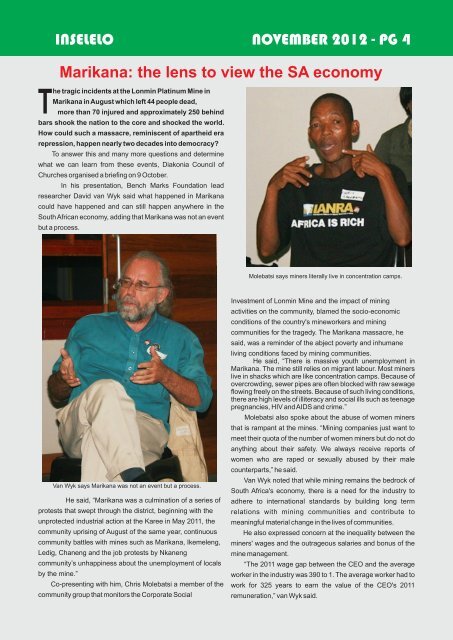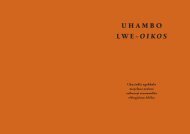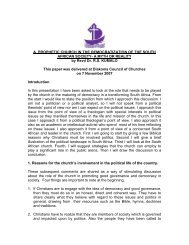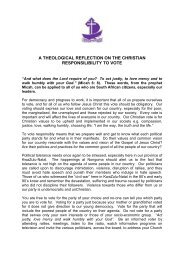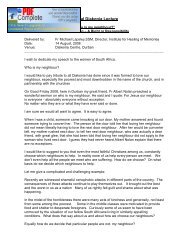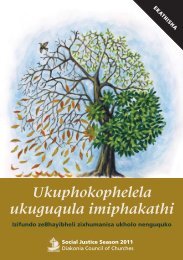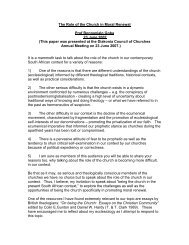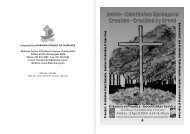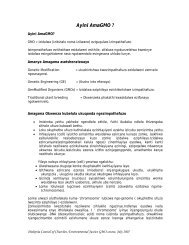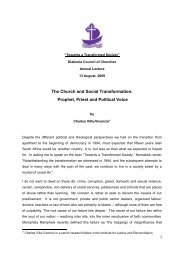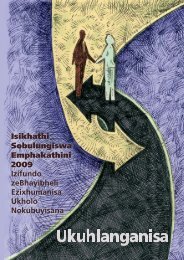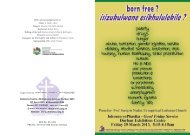Inselelo November 2012 - Diakonia Council of Churches
Inselelo November 2012 - Diakonia Council of Churches
Inselelo November 2012 - Diakonia Council of Churches
- No tags were found...
Create successful ePaper yourself
Turn your PDF publications into a flip-book with our unique Google optimized e-Paper software.
INSELELO NOVEMBER <strong>2012</strong> - PG 4Marikana: the lens to view the SA economyThe tragic incidents at the Lonmin Platinum Mine inMarikana in August which left 44 people dead,more than 70 injured and approximately 250 behindbars shook the nation to the core and shocked the world.How could such a massacre, reminiscent <strong>of</strong> apartheid erarepression, happen nearly two decades into democracy?To answer this and many more questions and determinewhat we can learn from these events, <strong>Diakonia</strong> <strong>Council</strong> <strong>of</strong><strong>Churches</strong> organised a briefing on 9 October.In his presentation, Bench Marks Foundation leadresearcher David van Wyk said what happened in Marikanacould have happened and can still happen anywhere in theSouth African economy, adding that Marikana was not an eventbut a process.Molebatsi says miners literally live in concentration camps.Van Wyk says Marikana was not an event but a process.He said, “Marikana was a culmination <strong>of</strong> a series <strong>of</strong>protests that swept through the district, beginning with theunprotected industrial action at the Karee in May 2011, thecommunity uprising <strong>of</strong> August <strong>of</strong> the same year, continuouscommunity battles with mines such as Marikana, Ikemeleng,Ledig, Chaneng and the job protests by Nkanengcommunity’s unhappiness about the unemployment <strong>of</strong> localsby the mine.”Co-presenting with him, Chris Molebatsi a member <strong>of</strong> thecommunity group that monitors the Corporate SocialInvestment <strong>of</strong> Lonmin Mine and the impact <strong>of</strong> miningactivities on the community, blamed the socio-economicconditions <strong>of</strong> the country's mineworkers and miningcommunities for the tragedy. The Marikana massacre, hesaid, was a reminder <strong>of</strong> the abject poverty and inhumaneliving conditions faced by mining communities.He said, “There is massive youth unemployment inMarikana. The mine still relies on migrant labour. Most minerslive in shacks which are like concentration camps. Because <strong>of</strong>overcrowding, sewer pipes are <strong>of</strong>ten blocked with raw sewageflowing freely on the streets. Because <strong>of</strong> such living conditions,there are high levels <strong>of</strong> illiteracy and social ills such as teenagepregnancies, HIV and AIDS and crime.”Molebatsi also spoke about the abuse <strong>of</strong> women minersthat is rampant at the mines. “Mining companies just want tomeet their quota <strong>of</strong> the number <strong>of</strong> women miners but do not doanything about their safety. We always receive reports <strong>of</strong>women who are raped or sexually abused by their malecounterparts,” he said.Van Wyk noted that while mining remains the bedrock <strong>of</strong>South Africa's economy, there is a need for the industry toadhere to international standards by building long termrelations with mining communities and contribute tomeaningful material change in the lives <strong>of</strong> communities.He also expressed concern at the inequality between theminers' wages and the outrageous salaries and bonus <strong>of</strong> themine management.“The 2011 wage gap between the CEO and the averageworker in the industry was 390 to 1. The average worker had towork for 325 years to earn the value <strong>of</strong> the CEO's 2011remuneration,” van Wyk said.


